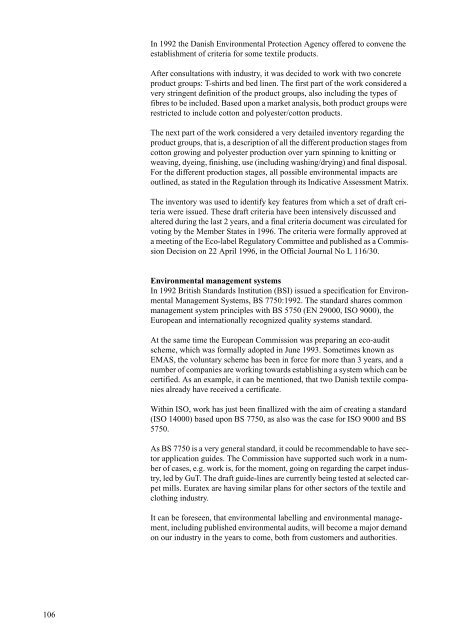Cleaner Technology Transfer to the Polish Textile ... - Miljøstyrelsen
Cleaner Technology Transfer to the Polish Textile ... - Miljøstyrelsen
Cleaner Technology Transfer to the Polish Textile ... - Miljøstyrelsen
Create successful ePaper yourself
Turn your PDF publications into a flip-book with our unique Google optimized e-Paper software.
106<br />
In 1992 <strong>the</strong> Danish Environmental Protection Agency offered <strong>to</strong> convene <strong>the</strong><br />
establishment of criteria for some textile products.<br />
After consultations with industry, it was decided <strong>to</strong> work with two concrete<br />
product groups: T-shirts and bed linen. The first part of <strong>the</strong> work considered a<br />
very stringent definition of <strong>the</strong> product groups, also including <strong>the</strong> types of<br />
fibres <strong>to</strong> be included. Based upon a market analysis, both product groups were<br />
restricted <strong>to</strong> include cot<strong>to</strong>n and polyester/cot<strong>to</strong>n products.<br />
The next part of <strong>the</strong> work considered a very detailed inven<strong>to</strong>ry regarding <strong>the</strong><br />
product groups, that is, a description of all <strong>the</strong> different production stages from<br />
cot<strong>to</strong>n growing and polyester production over yarn spinning <strong>to</strong> knitting or<br />
weaving, dyeing, finishing, use (including washing/drying) and final disposal.<br />
For <strong>the</strong> different production stages, all possible environmental impacts are<br />
outlined, as stated in <strong>the</strong> Regulation through its Indicative Assessment Matrix.<br />
The inven<strong>to</strong>ry was used <strong>to</strong> identify key features from which a set of draft criteria<br />
were issued. These draft criteria have been intensively discussed and<br />
altered during <strong>the</strong> last 2 years, and a final criteria document was circulated for<br />
voting by <strong>the</strong> Member States in 1996. The criteria were formally approved at<br />
a meeting of <strong>the</strong> Eco-label Regula<strong>to</strong>ry Committee and published as a Commission<br />
Decision on 22 April 1996, in <strong>the</strong> Official Journal No L 116/30.<br />
Environmental management systems<br />
In 1992 British Standards Institution (BSI) issued a specification for Environmental<br />
Management Systems, BS 7750:1992. The standard shares common<br />
management system principles with BS 5750 (EN 29000, ISO 9000), <strong>the</strong><br />
European and internationally recognized quality systems standard.<br />
At <strong>the</strong> same time <strong>the</strong> European Commission was preparing an eco-audit<br />
scheme, which was formally adopted in June 1993. Sometimes known as<br />
EMAS, <strong>the</strong> voluntary scheme has been in force for more than 3 years, and a<br />
number of companies are working <strong>to</strong>wards establishing a system which can be<br />
certified. As an example, it can be mentioned, that two Danish textile companies<br />
already have received a certificate.<br />
Within ISO, work has just been finallized with <strong>the</strong> aim of creating a standard<br />
(ISO 14000) based upon BS 7750, as also was <strong>the</strong> case for ISO 9000 and BS<br />
5750.<br />
As BS 7750 is a very general standard, it could be recommendable <strong>to</strong> have sec<strong>to</strong>r<br />
application guides. The Commission have supported such work in a number<br />
of cases, e.g. work is, for <strong>the</strong> moment, going on regarding <strong>the</strong> carpet industry,<br />
led by GuT. The draft guide-lines are currently being tested at selected carpet<br />
mills. Euratex are having similar plans for o<strong>the</strong>r sec<strong>to</strong>rs of <strong>the</strong> textile and<br />
clothing industry.<br />
It can be foreseen, that environmental labelling and environmental management,<br />
including published environmental audits, will become a major demand<br />
on our industry in <strong>the</strong> years <strong>to</strong> come, both from cus<strong>to</strong>mers and authorities.

















